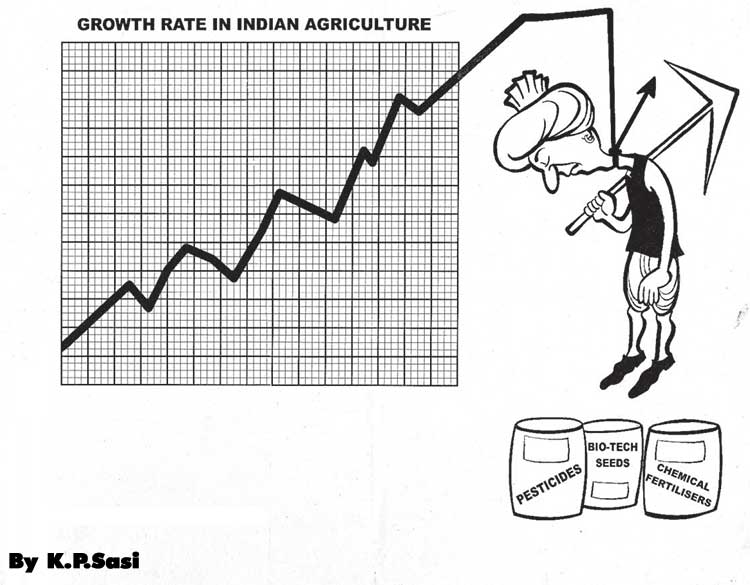
Figures on suicides released by the National Crime Records Bureau on October 28, 2021 show that 10,677 people related to agricultural sector committed suicide in the country during 2020. Among those who committed suicide were 5,579 farmers and 5,098 agricultural labourers. During 2019, 5957 farmers committed suicide, which is 5579 during 2020. These figures show a 6.35 per cent reduction in farmer suicides between 2019 and 2020. During 2019, 4324 agricultural labourers committed suicide, which is 5098 during 2020. These figures show a 17.9 per cent increase in agricultural labourers’ suicides between 2019 and 2020. Out of the suicides committed by farmers during 2020, 5335 were committed by men and 244 by women. Women account for 4.57 per cent of farmer suicides. Out of the total number of suicides committed by agricultural labourers during 2020, 4621 were committed by men and 477 by women. Women account for 10.32 per cent of agricultural labourers’ suicides.
The statistics being released from time to time by the National Crime Records Bureau on the number of suicides committed by farmers and agricultural labourers in the country have been criticized by various scholars and institutions. The bureau relies on the information provided by the State and Union Territory governments for compiling and releasing statistics on farmers and agricultural labourers’ suicides. The most frequent criticism of these governments is that they reduce the number of suicides committed by farmers and agricultural labourers to protect their image and send information to the National Crime Records Bureau. The bureau releases statistics on suicides by farmers and agricultural labourers on the basis of information provided by these governments, but does not mention the reasons for the suicides. Apart from farmers and agricultural labourers, rural artisans also contribute in the agricultural sector and the information regarding the number of suicides committed by them is not collected. In addition to the suicides reported by families of farmers and agricultural labourers, there are also suicides that they have committed after disappearing from their homes as a result of losing all hopes for their lives and their bodies being cremated as unclaimed bodies.
The country was facing a severe shortage of foodgrains before the First Five Year Plan (1951-56) since World War II. The first five-year plan gave priority to the agricultural sector, which helped overcome the problem. But as a result of prioritizing the development of the industrial sector during the Second Five Year Plan (1956-61), the country again faced a shortage of foodgrains. Drought in the country between 1964-66 exacerbated the food shortage. To overcome this problem, the Union government had imported food grains from the United States of America under P.L. 480 for which the country had to pay a high price.
To overcome the severe shortage of foodgrains, the Union government has decided to adopt ‘New Agricultural Technology’ in the country which is a package of high yielding seeds, assured irrigation, chemical fertilizers,insecticides, pesticides, fungicides, herbicides, and other chemicals, machinery, and modern agricultural practices. This technology was adopted on priority in the state of Punjab on the basis of its courageous farmers, agricultural labourers, and rural artisans and rich natural resources and later in other parts of the country in view of its success. The hard work of the country’s courageous farmers, agricultural labourers, and rural artisans, and the overuse of natural resources, overcame the serious problem of severe food shortage, but the government’s agricultural policies, weakened social relations due to the commercial spirit of the ‘New Agricultural Technology’ package, the ‘new economic policies’ of liberalization, privatization, and globalization in the country since 1991 and some other factors have deteriorated the socio-economic conditions of farmers, agricultural labourers and rural artisans drastically.
During 1951, 82 per cent of the country’s population depended on agriculture for their livelihood, which was given a share of 55 per cent of the national income. At present, about 50 per cent of the country’s population is dependent on agriculture for their livelihood, but in 2018-19, this half of the population was given a share of 16 per cent in the national income. In the distribution of national income, the biggest hit among the agriculturally dependent classes is on the marginal, and small farmers, agricultural labourers, and rural artisans.
Released statistics and research studies on suicides of farmers and agricultural labourers have revealed the fact that marginal, and small farmer suicides are a major component among farmers and the number of agricultural labourers’ suicides is on the rise. Poverty and debt, as well as a deterioration in social relations are the main reasons for the suicides of these two categories in the agricultural sector.
Marginal, and small farmers constitute 88 per cent of the total farmers out of which 77 per cent are marginal farmers (who own less than 2.5 acres of land) and 17 per cent are small farmers(who own 2.5 and less than 5 acres of land). These farmers have very little surplus produce to sell in the market. Non-profitability of MSP for agricultural commodities, non-purchase of all agricultural commodities even at MSP, financial problems, reduction in working days,handing over the pricing of inputs used in agricultural production to the unregulated market, the lack of employment opportunities in the non-agricultural sector, and the like are responsible for the poor plight of marginal, and small farmers.
While the use of herbicides and machinery in the package of ‘New Agricultural Technology’ has hit employment in the agricultural sector hard, the biggest hit has been on agricultural labourers, and rural artisans because they have no other means of production except selling their own labour. The growing number of suicides by the country’s agricultural labourers, especially women, is a risky endeavor as employment in the agricultural sector is declining rapidly for them, but there are no employment prospects in the non-agricultural sectors. Social relations amongst farmers, agricultural labourers, and rural artisans were warm before the adoption of the ‘New Agricultural Technology’. Farmers, agricultural labourers, and rural artisans were sharing the agricultural production even if it was not fair. In times of crisis, big farmers helped the marginal, and small farmers, agricultural labourers, and rural artisans financially and otherwise. The commercial spirit of the ‘New Agricultural Technology’’ has weakened the social relations amongst the various sections of the agricultural sector.
The contribution of the agricultural sector to the survival of human beings should not be overlooked. So, the present time is giving a wake up call to governments, society, and farmers, and agricultural labourers themselves. This can only be possible if governments formulate and implement their agricultural policies in favour of the sections dependent on the sector. The relatively affluent sections of the society have to stand up for them in view of their contribution. The three sections dependent on the agricultural sector have to come forward to adopt the cooperative farming system. The unions of farmers and agricultural labourers must educate their members that committing suicides is no solution at all to their problems. The peaceful and democratic struggles by these sections of the farming community would be helpful in raising and solving their problems. In order to solve the problems of the farming community, the government must adopt a pro-people and nature- friendly economic growth model.
Dr. Gian Singh, Former Professor, Department of Economics, Punjabi University, Patiala.










































